Want To Grow Purchase Conversions? Aim For Fame! The Stronger Your Brand Awareness, The Greater The Sales Effect
Click here to view a 15-minute video of the key findings.
Click here to download a PDF of the slides.
A series of new studies from NCSolutions, TikTok, and podcast attribution firm Podscribe sheds light on what drives sales effect. Surprisingly, some of the most frequently discussed media tactics show little to no difference in cost of acquisition.
Key findings:
- Creative quality is the number one sales driver according to NCSolutions. This is a surprise to advertisers and media agencies who think media tactics (targeting, reach, etc.) drive the most sales.
- A major study from TikTok reveals the greater a brand’s awareness, the greater the purchase conversion. Brands with high aided awareness have 2.86X greater conversion rates compared to low awareness brands.
- Purchase conversion varies widely by advertising category, Podscribe reports. It’s good to understand the purchase conversion benchmarks for your product category.
- Small/medium podcasts (<750,000 monthly audience) have purchase conversions that are 2X those of larger podcasts (>1,000,000 monthly audience).
- Three frequently discussed media options show little difference in cost per acquisition (single show placement vs. run of network, host-read ads versus producer creative, ad lengths from 30 seconds to 75 seconds): In most cases, differences in CPMs generate similar cost per acquisition.
- Pre-roll and mid-roll placements have similar sales effect. Post-roll placements have pricey cost per acquisition.
- Podcast genres have wide differences in purchase conversion and cost per acquisition.
Marketers vastly understate the sales effect of creative and significantly overestimate the impact of targeting
The Five Keys to Advertising Effectiveness, released in August 2023 by NCSolutions and Nielsen, is based on nearly 450 sales effect studies and over a decade of experience linking advertising to sales results. The key sales drivers are listed on the right hand of the slide below.
To the left are the perceived rankings of sales drivers among national marketers, according to a February 2025 study by Advertiser Perceptions. Marketers massively underestimate the immense sales effect power of creative.
Creative, according to NCSolutions, drives half of sales. This is nearly 2.5 times what advertisers perceive. The Advertiser Perceptions February 2025 study reports brands and media agencies say creative only represents 21% of total sales effect.
Marketers consider targeting the number one sales driver at a 25% contribution. What does the marketing science say?
Per NCSolutions, targeting ranks a distant fourth, generating only 11% of sales effect. The sales contribution perception of targeting is twice the reality.
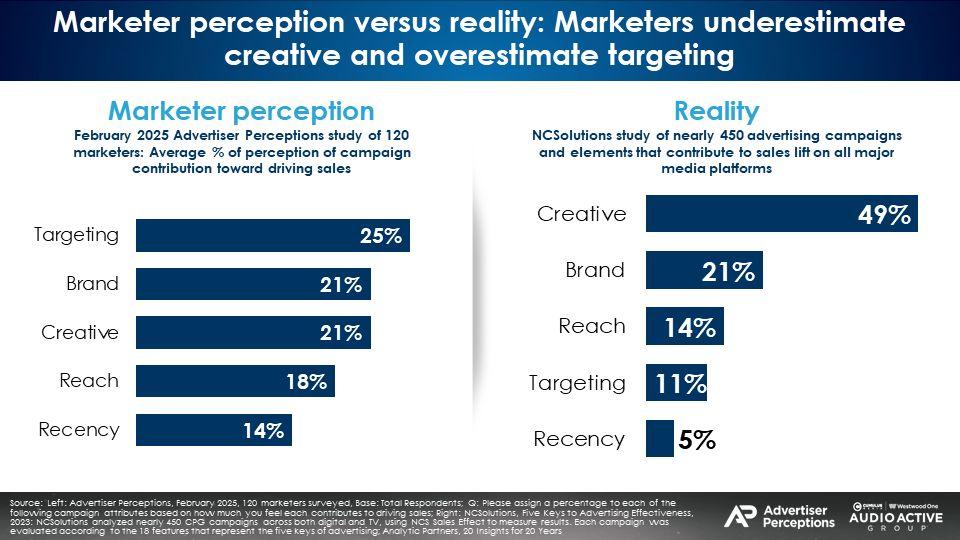
TikTok: Be known before you’re needed: A strong brand makes your performance marketing work harder
A great new study from Tracksuit, the brand tracking firm, reveals how aided awareness drives conversion rate and improves performance efficiency. The study, conducted in partnership with TikTok, analyzed a large number of campaigns and compared sales response with the advertisers’ brand strength. Tracksuit found:
- The greater the awareness, the greater the conversion rate: There is a direct relationship between aided awareness and conversion rate.
- Stronger brand awareness improves performance marketing impact by as much as 2.86X: The stronger your brand, the greater your performance efficiency. Compared to low-awareness brands, medium-awareness brands generate 1.48X greater conversion. Brands with high aided awareness have 2.86X greater conversion rates compared to low awareness brands.
- Brand awareness is a controlling factor for the outcomes of performance marketing: Brand is the foundation on which performance success is built: the stronger the brand, the stronger the foundation.

Podscribe: Q4 2024 Podcast Performance Benchmarks
Podscribe’s analysis is based on twelve months of campaigns from 240+ advertisers with a total of 20 billion impressions.
Topline norms:
- .21% visitor rate (% of impressions that become a visitor)
- .016% conversion rate (% of impressions that convert to purchase)
- $116 cost per acquisition (CPA = ad cost for a purchase)
Smaller podcast shows with less than 750,000 monthly impressions generate more visitors per impression with lower cost per acquisition
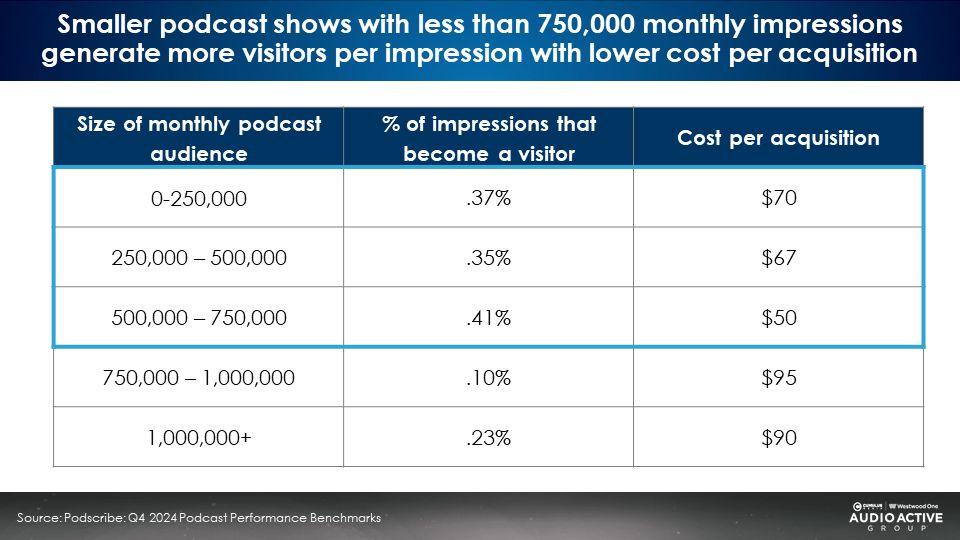
Analysis: “Large shows (have) higher CPMs, more casual listeners who are less connected to the host and less likely to engage with ads. As a result, conversion rate is lower and CPAs are higher. Smaller shows (<750,000) have lower CPMs, audiences that are highly engaged and loyal, with strong listener-host connection which generates increased ad receptivity. This results in higher conversion rates and lower cost per acquisition costs.”
Podcast advertising effects take place over an extended period of time: 80% of visitor impact occurs between day two and thirty
Half of visitor impact occurs between day eleven and day thirty.
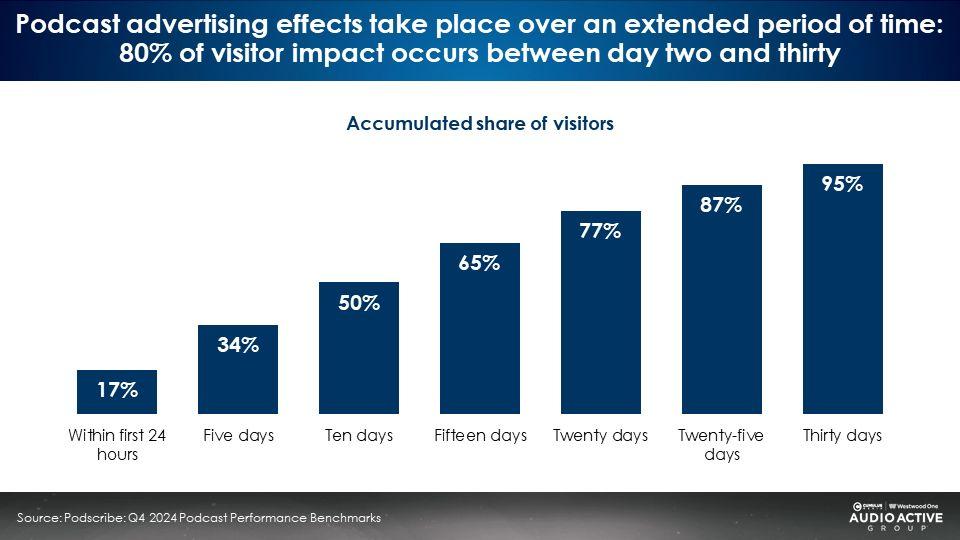
Analysis: Only 17% of visitors occur within the first day. It takes another 29 days to accumulate the remaining 80% of attributable site visitors. However, major studies on advertising effectiveness reveal a 30-day window captures only a third of total advertising sales effect and profit impact.
Ebiquity’s “24%-18%-58% rule”: Nearly 60% of advertising impact occurs between 14 weeks and two years
One of the world’s largest studies of advertising effectiveness reveals the vast majority of advertising impact occurs between week 14 and two years. Via significant media mix modeling and econometric analysis, the study found:
- 24% of advertising pays back in the same week. Thus, a quarter of advertising’s overall contribution to profit occurs immediately.
- 18% of advertising profit impact occurs between week two and week 13.
- 58% of advertising return occurs between week 14 and two years.
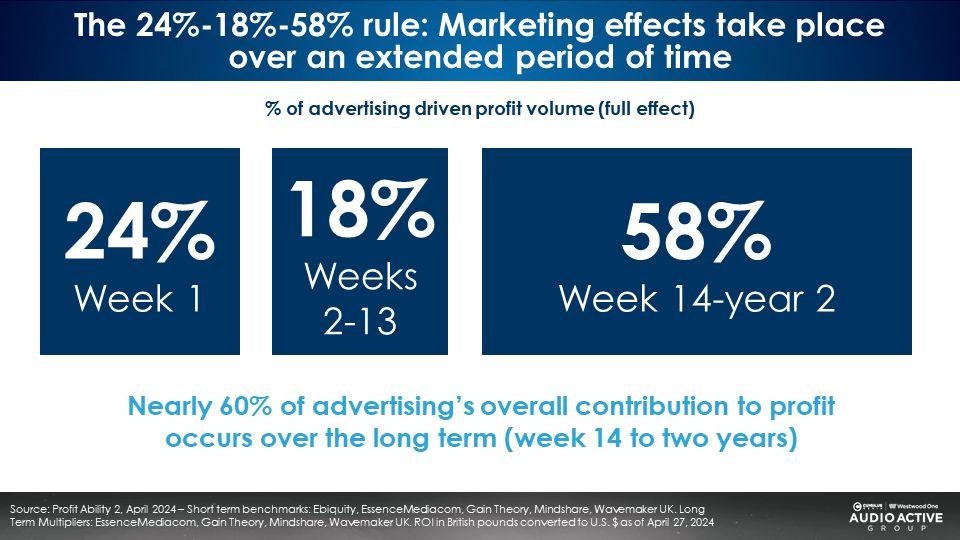
Profit Ability 2: The New Business Case for Advertising was a massive undertaking that involved:
- $2.2 billion in media spend analyzed (2021-2023)
- 142 brands
- 14 sectors
- 10 media channels
- 53 brands matched pre- and post-COVID
Profit Ability 2: The New Business Case for Advertising is a meta-analysis of econometric benchmarks to understand the short- and long-term payback of advertising to business profit.
The study uses marketing mix modelling (MMM) to link advertising spend to incremental profit. Marketing mix modeling is the gold standard for understanding media effectiveness. It’s a statistical modelling approach that isolates the contribution of advertising from other factors that drive a business (pricing, distribution, seasonality, etc.).
Run of network campaigns generate lower CPA costs than single podcast show campaigns
While purchase conversions for single show campaigns are higher than run of network, CPM differentials make run of network more effective for the investment.
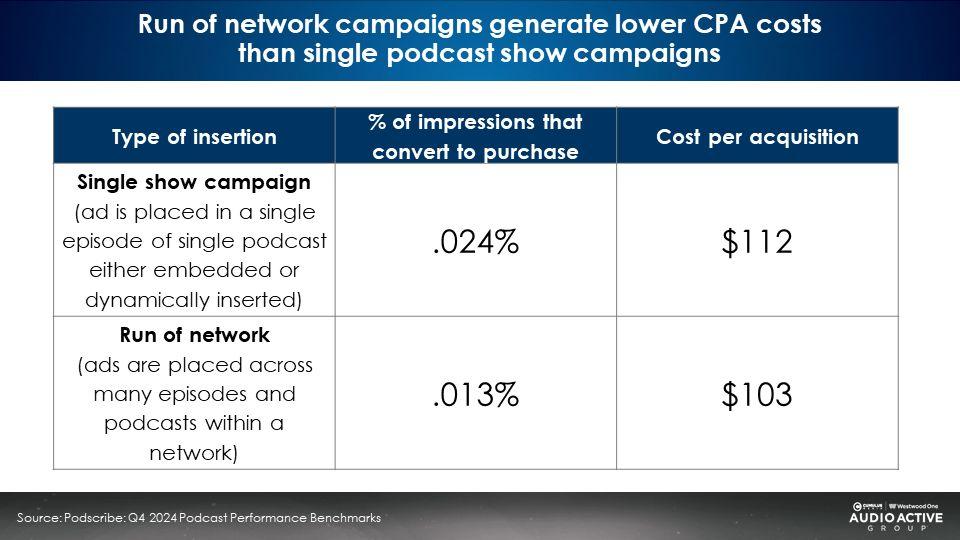
Analysis: One of the most frequently asked questions by advertisers new to podcast advertising is, “Should I execute single show insertions or run of network?” Single show insertions are a premium ad placement deserving premium CPMs. Single show insertions generate purchase conversions 2X that of run of network. However, the CPM differential means run of network generates a more affordable cost per action than single show campaigns.
Host-read ads generate 15% more conversions than producer reads, yet cost per acquisition costs are similar due to CPM differentials
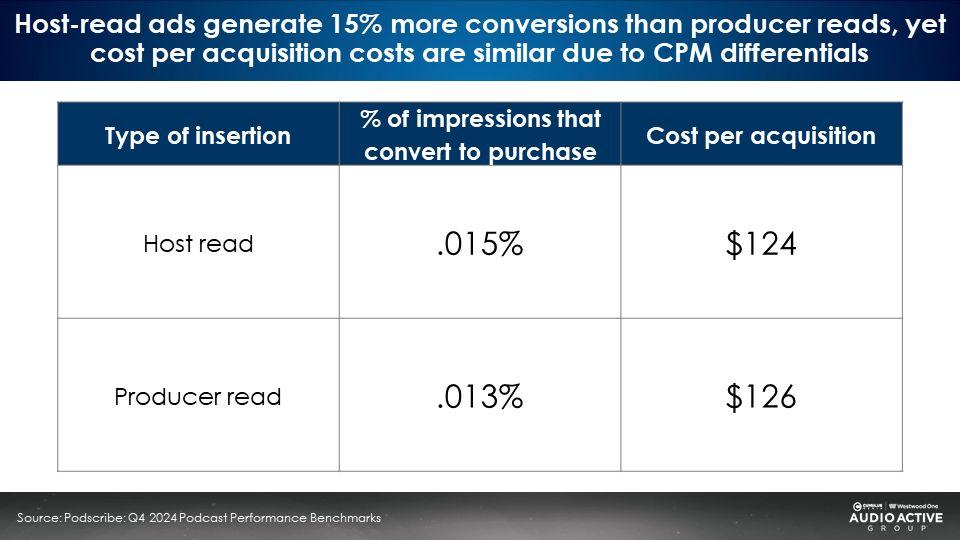
Analysis: Far too much discussion occurs on the merits of host read versus producer read or pre-produced ads. Yes, host-read ads account for 15% more purchase conversions and represent a premium ad placement deserving premium CPMs. Yet, the cost per acquisition costs of the two methods is similar due to the CPM differential.
Fifteen-second podcast ads are very costly on a cost per acquisition basis; Ads between thirty seconds and seventy-five seconds yield similar conversions and cost per acquisition
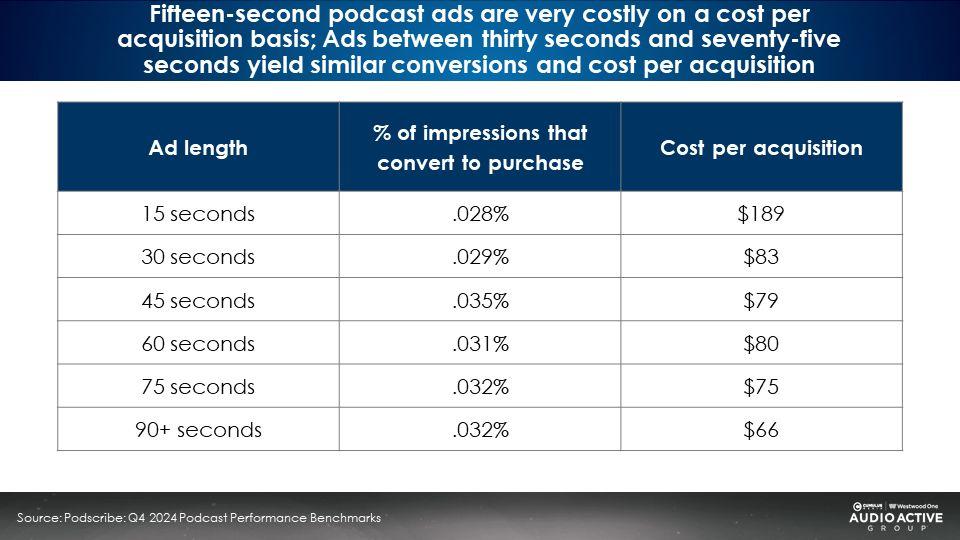
Analysis: Beyond fifteen seconds, there is very little difference in purchase conversions or cost per acquisition by ad length. This mirrors the findings of AM/FM radio creative effectiveness studies which reveal very little campaign effect differences between thirty-second ads and sixty-second ads.
Legendary audio ad creative Chris Smith, Principal and Chief Creative Officer at Plot Twist Creativity Dallas, cautions:
“A lot of advertisers think that because audio affords you sixty or thirty seconds, they have the time to say everything there is to say about their brand. It’s why so many commercials end up sounding like laundry lists. The truth is, if you want to talk about everything, then you really have nothing to talk about.
In advertising, you need to have one thing to say. Audio’s sixty seconds of ad time just gives you the chance to say it in an entertaining and memorable way.
A radio spot is not a hotel: You don’t have to fill all the space
Advertisers think they have to take the amount of time they have and fill it up with words or music. Many forget that silence is a storytelling element, too.
Every second of an ad doesn’t have to be filled. No commercial needs to be wall-to-wall talking, sound effects, or music. Sometimes silence draws people in more.”
Pre-rolls and mid-rolls have similar purchase conversion and cost per acquisition; Post-rolls have lower conversion and higher cost per acquisition
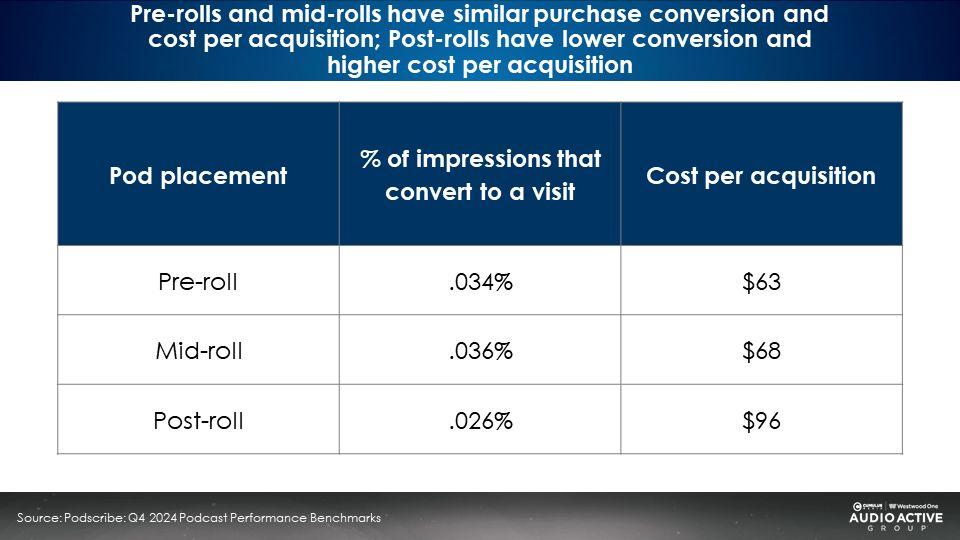
Analysis: There is little difference between mid-roll and pre-roll visit conversions and CPA. Post-rolls have lower visit conversion and pricy cost per acquisition.
There is large variation in podcast advertiser category purchase conversion and cost per acquisition
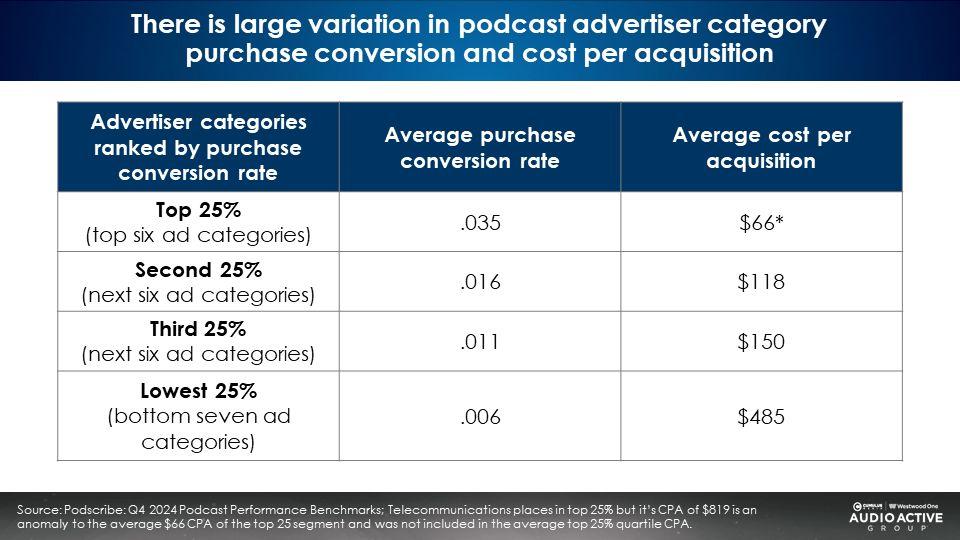
Podcast advertiser category: There is a wide difference in purchase conversation rate and cost per conversion
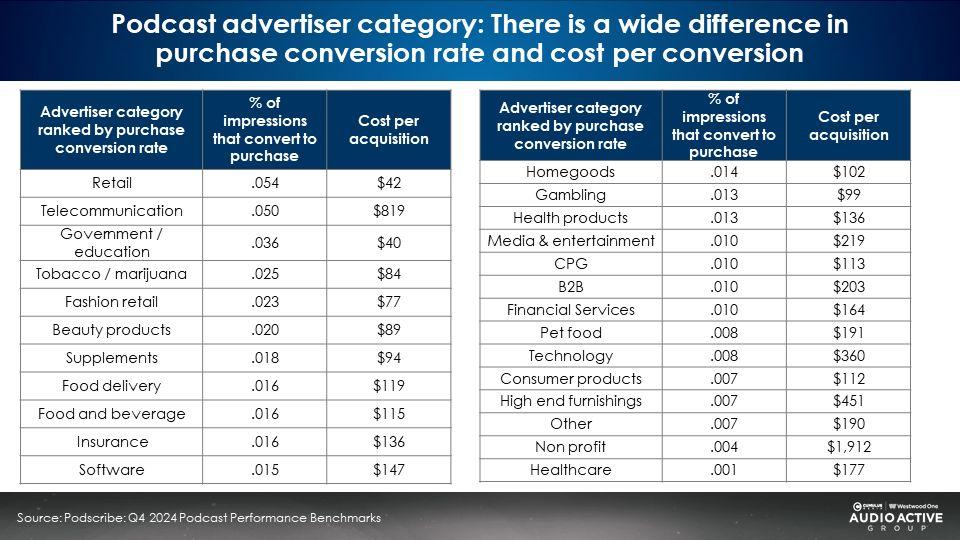
Podcast genre conversion rate and cost per acquisition: The top 10 genres have the same cost per conversion rate
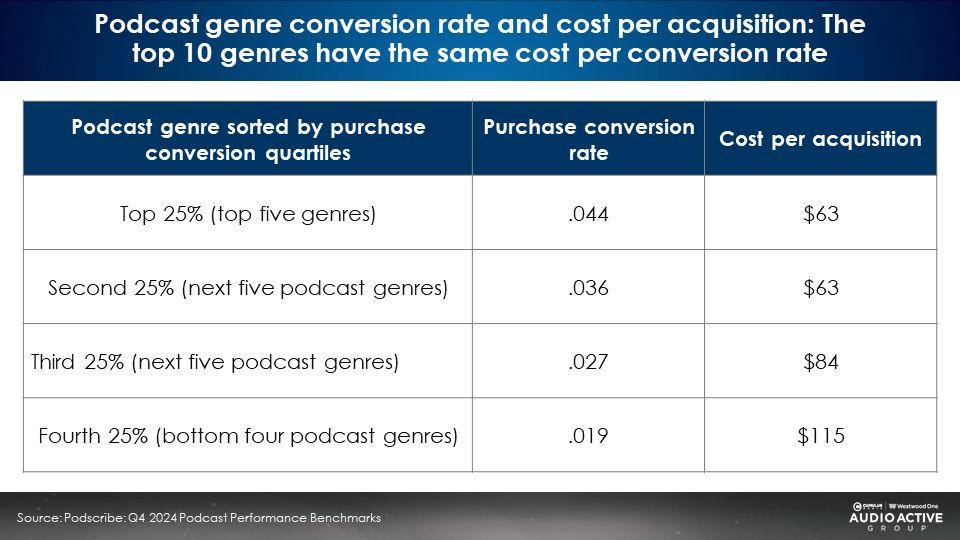
Per Podscribe, here are the purchase conversion rates by podcast genres:
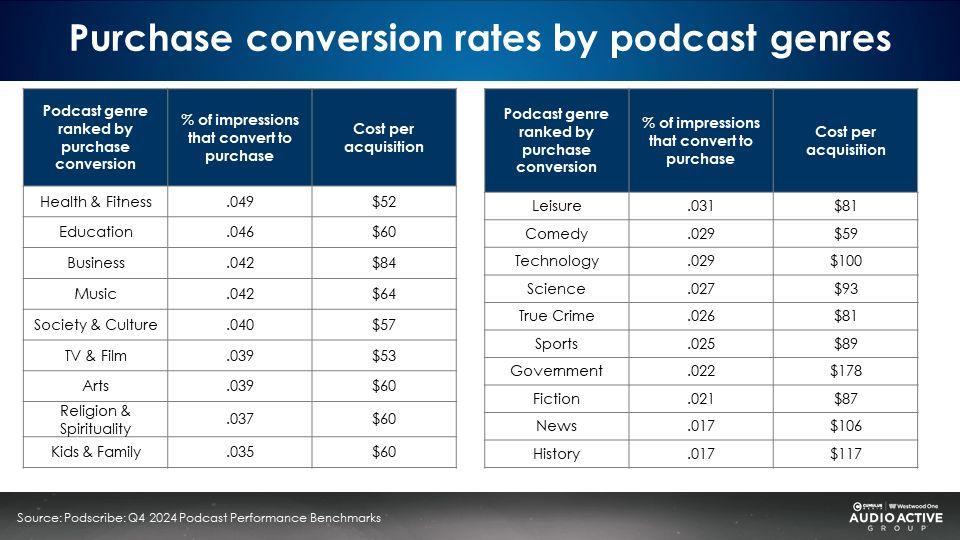
Key findings:
- Creative quality is the number one sales driver according to NCSolutions. This is a surprise to advertisers and media agencies who think media tactics (targeting, reach, etc.) drive the most sales.
- A major study from TikTok reveals the greater a brand’s awareness, the greater the purchase conversion. Brands with high aided awareness have 2.86X greater conversion rates compared to low awareness brands.
- Purchase conversion varies widely by advertising category, Podscribe reports. It’s good to understand the purchase conversion benchmarks for your product category.
- Small/medium podcasts (<750,000 monthly audience) have purchase conversions that are 2X those of larger podcasts (>1,000,000 monthly audience).
- Three frequently discussed media options show little difference in cost per acquisition (single show placement vs. run of network, host-read ads versus producer creative, ad lengths from 30 seconds to 75 seconds): In most cases, differences in CPMs generate similar cost per acquisition.
- Pre-roll and mid-roll placements have similar sales effect. Post-roll placements have pricey cost per acquisition.
- Podcast genres have wide differences in purchase conversion and cost per acquisition.
Click here to view a 15-minute video of the key findings.
Pierre Bouvard is Chief Insights Officer of the Cumulus Media | Westwood One Audio Active Group®.
Contact the Insights team at CorpMarketing@westwoodone.com.